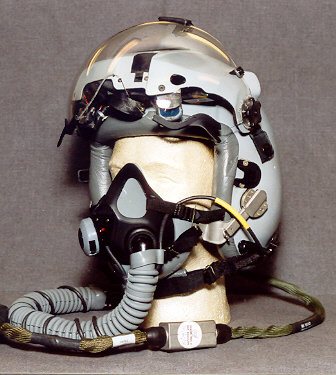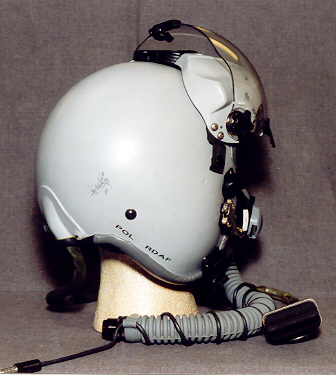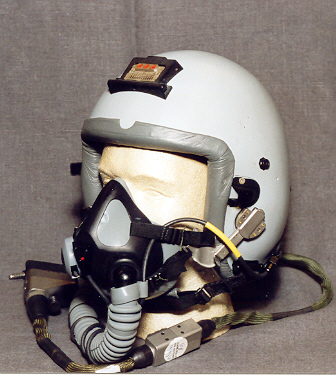Joint Helmet Mounted Cueing System
Message 129, 11 December 2003:
Last week I was lucky enough to get a closer look at the Joint Helmet Mounted Cueing
System (JHMCS). Together with Belgium, the Netherlands and Norway, Denmark is
participating in the Operational Test & Evaluation of the F-16 Mid-Life Update version
M3 which, among other things, adds the JHMCS capability. In that connection two of our
pilots are flying with the JHMCS regularly.
I was surprised to feel how light the system was. My impression from just looking at the
system was that it would be a nuisance to wear when pulling 9g but apparently it is not a
problem. The pilot I talked to said that due to the reclining ejection seat the center of
gravity was not as far forward as it looks and he felt quite comfortable pulling g's.
You will note that the helmet is prepared for Combat Edge but not modified. The RDAF has
decided not to adopt Combat Edge because of the bulkiness of all the system components.
This is also why the MBU-20/P oxygen mask looks like an HA/LP mask. It IS an MBU-20/P but
the hose for the occipital bladder has been removed.
Cheers, Bluelight






All pictures © Bluelight
Message 130, 12 December 2003
Bluelight,
Damn! That's a good looking piece of gear and mighty interesting info you have posted.
I am wondering how the JHMCS interfaces with the current weapon systems. Does the current
Sidewinder have sufficient gimbal limits to make full use a JHMCS, or would they be
testing it in anticipation of the AIM-9X ?
Also, interesting to note that RDAF considered the occipital bladder and rubber interface
hose for mask & bladder as bulky. I was always under the impression that these items
were negligible in terms of bulk and weight...I suppose the RDAF has good reasons to leave
them out.
Cheetah
Message 132, 12 December 2003
Hi Bluelight,
Thanks for the fascinating details and visual images of the RDAF JHMCS trials set-up.
Those are excellent views you provided and I have followed suit, copying them to my own
archives. The cuing system visor mechanism does look heavy and somewhat bulky, but I would
probably also be surprised to find it lighter in weight than it actually looks (as you
were). Since this is pretty much still first-gen stuff, one can only imagine what advances
in miniaturisation will yield for an advanced version in future, eh? [I found
Cheetah's question about the gymbaling AIM suitability interesting, as well.]
The clear blast visor appears to meet the helmet at the mask interface area in a favorably
enhanced angle for deflecting wind blast effects, too. This is a feature that was first
explored on the TopTex's standard hard external visor, but which has apparently found
subsequent favor in a number of advanced helmet designs after several generations of wind
blast effects testing.
Cheers, DocBoink
Message 133, 12 December 2003
Hi Cheetah,
In the current F-16 Mid-Life Update software version (M3) they are mainly testing the HUD
functions of the JHMCS i.e. the functions associated with the main CRT assembly. If you
look at the pictures of the Head Display Unit the CRT is the large black pipe which has a
golden cylinder at one end and a square(ish) projector window at the other. The High
Off-Boresight Seeker (HOBS) functions are associated with the two Up-Look Reticles (also
called puppers). They are the two black cylindrical shapes protruding on each side of the
CRT projector window. These puppers will not be activated until later in the testing
programme.
I think the decision regarding the Combat Edge was not made on the relative merits of the
Combat Edge system alone. It was because of the combined bulk of Combat Edge, parachute
harness, life preserver, CSAR vest, anti-exposure suit etc. And I guess that economy
probably reared its ugly head in that equation as well.
Cheers,
Bluelight
Message 134, 12 December 2003
Hi DocBoink,
I believe that the angle of the clear visor is determined more by its function as a
projector screen than its windblast deflection function. The latter is of course an
important function when ejecting but reflections need to be kept at an absolute minimum to
avoid interference with the HUD and weapons cueing information. The forward-leaning visor
is inspired by the same considerations as the windows in an air traffic control tower.
BTW, due to the obvious need to minimize distortions in HUD informations the visor glass
is made to very strict optical specifications and they have special coating to match the
CRT and the puppers. Therefore they are very expensive (a pricetag in excess of $3,000 was
mentioned). The visors need to be adapted to each individual pilot to fit the profile and
position of his oxygen mask, so some grinding and sanding on the lower edge is called for.
The ALSE guys need to be very careful when doing this. Otherwise they will be throwing
away $3,000 every time they grind away too much or scratch the surface.
Cheers, Bluelight
Message 137, 12 December 2003
For Doc: Not trying to be critical here but the JHMCS helmet is actually the end result of
about 15 years of refinement and has roots in the agile eye, cats eye et al programs which
can trace their roots all the way back to the early VTAS I and VTAS II.
Figmo
Message 139, 12 December 2003
Hi Bluelight.
Yes, of course. I should have said that 'coincidentally' the resulting visor angle is more
favorable to wind-blast deflection, thereby cancelling an out an incorrect implication
that it resulted from a deliberate effort to reduce wind-drag considerations. You are
completely correct about the deliberate and specific projection requirements that
determined the visor's angle to a frontal plane, but the resulting angle is (perhaps
ironically and curiously) better suited to deflecting wind-blast and enhancing mask
retention than the older style frontal plane (as found on say, P-series visors).
Interesting how an entirely different set of design criteria can sometimes achieve a
perhaps unintended but nonetheless favorable result. I'd love to see some of the actual
test data from USAF wind-blast visor studies done in past decades, BTW.
Your remarks on ALSET provided 'customising' of the visor/mask interface for crew were
thought provoking. I can see such a thing happening inadvertently, with costly results!
Cheers, Doc(always has an explanation)Boink





